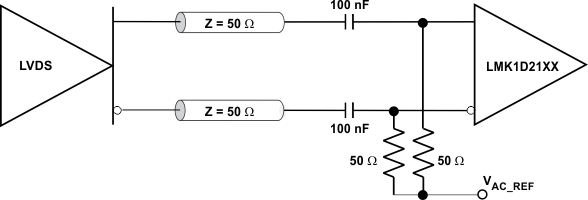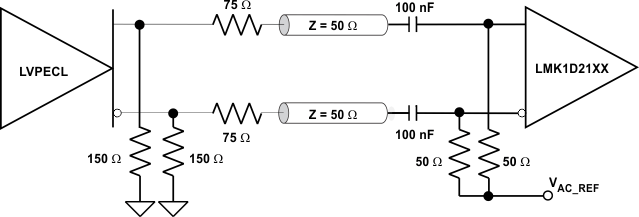SNAS888A September 2024 – November 2024 LMK1D2102L , LMK1D2106L
PRODUCTION DATA
- 1
- 1 Features
- 2 Applications
- 3 Description
- 4 Device Comparison
- 5 Pin Configuration and Functions
- 6 Specifications
- 7 Parameter Measurement Information
- 8 Detailed Description
- 9 Application and Implementation
- 10Device and Documentation Support
- 11Revision History
- 12Mechanical, Packaging, and Orderable Information
パッケージ・オプション
デバイスごとのパッケージ図は、PDF版データシートをご参照ください。
メカニカル・データ(パッケージ|ピン)
- RHA|40
サーマルパッド・メカニカル・データ
発注情報
8.4.3 Input Termination
The LMK1D210xL inputs can be interfaced with LVDS, LVPECL, HCSL, or LVCMOS drivers.
LVDS drivers can be connected to LMK1D210xL inputs with DC and AC coupling as shown Figure 8-5 and Figure 8-6, respectively.
 Figure 8-5 LVDS Clock Driver Connected to LMK1D210xL Input (DC-Coupled)
Figure 8-5 LVDS Clock Driver Connected to LMK1D210xL Input (DC-Coupled) Figure 8-6 LVDS Clock Driver Connected to LMK1D210xL Input (AC-Coupled)
Figure 8-6 LVDS Clock Driver Connected to LMK1D210xL Input (AC-Coupled)Figure 8-7 shows how to connect LVPECL inputs to the LMK1D210xL. The series resistors are required to reduce the LVPECL signal swing if the signal swing is >1.6VPP.
 Figure 8-7 LVPECL Clock Driver Connected to LMK1D210xL Input
Figure 8-7 LVPECL Clock Driver Connected to LMK1D210xL InputFigure 8-8 shows how to couple a LVCMOS clock input to the LMK1D210xL directly.
 Figure 8-8 1.8V, 2.5V, or 3.3V
LVCMOS Clock Driver Connected to LMK1D210xL Input
Figure 8-8 1.8V, 2.5V, or 3.3V
LVCMOS Clock Driver Connected to LMK1D210xL InputFor unused input, TI recommends grounding both input pins (INP, INN) using 1kΩ resistors.